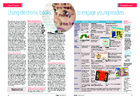| dc.description.abstract | Electronic books offer a fun, interactive, multimedia rich approach to sharing stories
with children. Although teaching reading has traditionally focused on using conventional
printed books, there is a growing shift towards interactive reading approaches,
some of which may incorporate digital media. Accompanied by a variety of interactive
features such as animation, sound effects, hyperlinked vocabulary, hidden
hotspots and gradual revelation of text – e-books have the potential to further
involve young learners in the reading process. While some studies highlight the
impact of using electronic storybooks for independent learning purposes (e.g.
Moody, 2010), this article explores ideas on how teachers can create and use electronic
books with a whole class using the shared reading approach. E-books have
the potential to be motivating, challenging and a colourful visual resource in the
primary school classroom – use them to increase children’s interest, involvement
and understanding of stories. | en_US |


